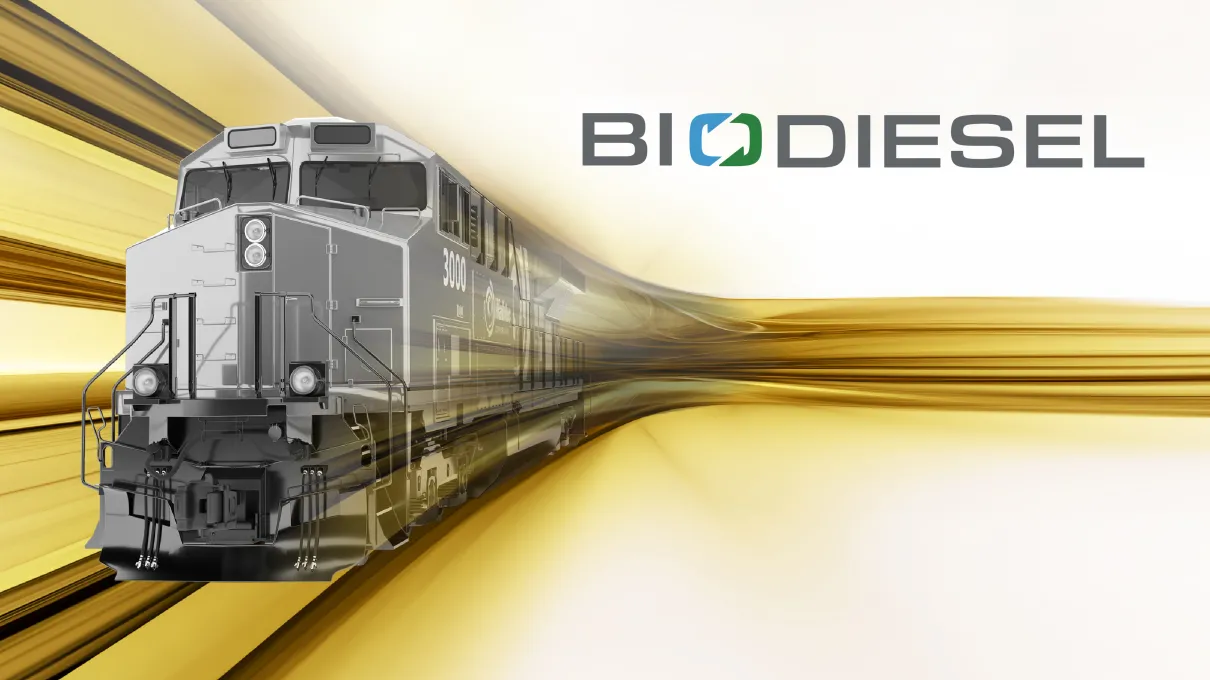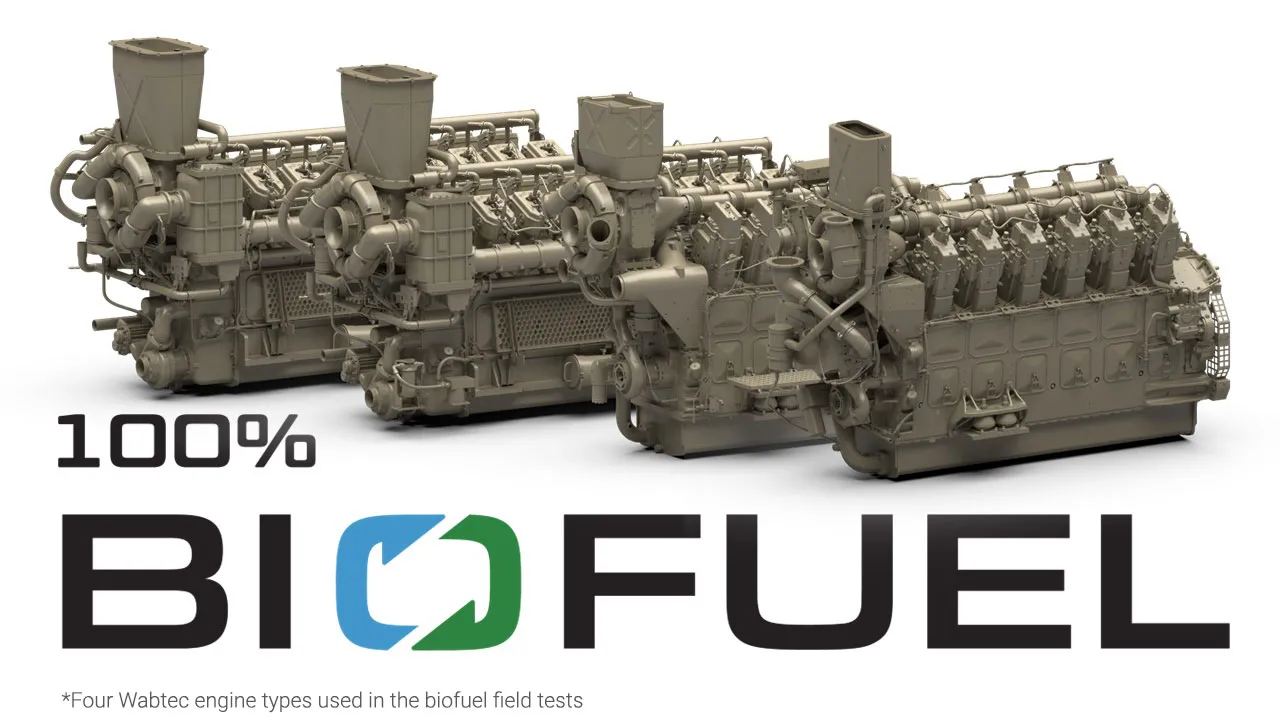
The Bold and the Biofuels: Driving Alternative Fuels Adoption on the Road to Net Zero
Envision a future where freight locomotives fuel up in California with R100 renewable diesel, top off in North Platte, NE, with B20 biodiesel, run on B13 in Chicago, IL, then traditional diesel in Baton Rouge, LA, before heading to Alberta, Canada, to be attached to a tender and powered by a hydrogen internal combustion engine (H2 ICE).
This “patchwork-fuel” future, one shaped by local incentives, could happen sooner than anyone might have anticipated as near-term emission-reduction plans, the growing commercial availability and viability of biofuels, ongoing innovation, industry collaboration, and net zero pledges converge on environmental sustainability.
A phased approach to sustainability
That the route of a railroad could be powered by different fuel types based on geography reflects a distinct set of near- and long-term emission-reduction goals, and a healthy ecosystem for alternative-fuels development and testing.
But first things first. North America’s leading railroads are taking environmental sustainability very seriously and have each pledged to reduce emissions 30-40% by 2030. These goals are backstopped by an even bigger promise, reaching net-zero emissions by 2050.
Entering 2024, that leaves six years to achieve 2030 commitments and only 26 to attain net zero. Fortunately, Wabtec and its network of Class I carrier customer/partners and alternative fuel providers are off to a fast start.
Three levers: strategies for meeting near- and long-term reduction goals
Wabtec sees three innovation “levers” it can pull to support customers in their sustainability journeys: fuel savings, carbon reduction, and net zero technologies, with each having its time and place in the transition.
- Fuel-reduction solutions – For every gallon of fuel saved, 22 pounds of CO2 emissions are avoided and fuel costs significantly reduced. But squeezing out additional fuel efficiency is hard to do. Wabtec’s premier fuel-saving technology, FDL Advantage (FDLA), has already provided carriers a 5 percent fuel efficiency boost. While Wabtec continues to invest in fuel savings improvements on its Evolution Series locomotives, at some point it will be hard to squeeze more fuel out of the already extremely efficient locomotive engines.
- Carbon-reduction solutions – Much as natural gas is seen as a “bridge fuel” in the overall economy’s transition to 100% renewable energy, biofuels are where the rail industry is making its biggest bets to meet 2030 emissions pledges and act as a bridge to future reductions. Already, Wabtec has tested and approved B5 (5% biodiesel) and R30 (30% renewable diesel) in all of its locomotive engines, with B11 and R50 on pace for approvals by the end of 2023. Driven by carrier demand, B20 and R100 are projected to be ready for commercial use in Q3 2024. The product of a breakthrough collaboration among Wabtec and its customers (see more below), the availability of biodiesel and renewable diesel, and accompanying engine upgrades to accommodate them will enable carriers to “mix and match” fuel types from region to region while radically reducing well to wheel emissions by up to 60%!
- Net zero solutions – Just as fuel-efficiency can only get the industry so far towards net zero, so too with biofuels, due to their lower, but not zero, carbon intensity. The solutions for running net zero freight locomotives are currently believed to lie in hydrogen and electric batteries. And while batteries are a popular clean technology, they currently only offer ~10% of the range (measured in MWh) of today’s diesel engines. That, of course, could change by 2050 based on potential battery breakthroughs, such as solid-state technology, but industry and government attention is on the potential of hydrogen, both as a fuel for a H2 ICE (complementing biofuel compatible engines) and as a standalone fuel cell.
Making it happen: field tests
Wabtec’s innovation engine is running full throttle to explore, test, and operationalize the use of alternative fuels. And while the development of kits to safeguard legacy engines for the use of biofuels represents one of these innovations, the real leap forward is being driven by a unique and tight collaboration among carriers with Wabtec, and an openness to sharing results with each other.
“A lot goes into ensuring biofuels are a safe, reliable, durable, and effective fuel for locomotives, and our customers are entrusting us to do that investigative work on their behalf,” said Chris Miller, Senior Director, Services Product Management, at Wabtec. “Some of that critical upfront work is being done behind the scenes at Wabtec, but a lot of it is happening in extensive field testing directly with our customers.

Field testing is crucial in determining how biofuels will perform in real operating environments and impact locomotive components. Will biodiesel cause engine leaks or corrosion? What will happen to engine performance at high altitudes, high ambient temperatures, or subfreezing weather? Will maintenance intervals change?
These are some questions being answered in Wabtec’s extensive field tests with the industry.
In fact, when you ask Chris Miller where Wabtec is innovating most in biofuels, he doesn’t point to “product,” he points to an “approach” unique in the industry.
“The major innovation here is the way Wabtec is working with its customers, partners, and fuel providers to learn and grow together,” says Miller.
That approach is personified by the aforementioned field tests and a trailblazing technical conference Miller launched in 2022, The Alternative Energy Conference. This technical event brings together customers from around the globe, leading alternative fuel providers, and Wabtec experts. Now in its second year, the gathering offers a safe place to share information, including results from the field tests, and learn from each other to drive decarbonization progress in the industry.
“Our carrier partners deserve the bulk of the credit here,” offers Miller. “They have realized that the problem of climate change and achieving decarbonization can best, and perhaps only be solved through collaboration. I am incredibly proud of the effort we are making together in service of a better planet and railroad industry.”
The hydrogen future
So, while biofuels are in extensive field testing, where is hydrogen in its evolution as a railway fuel?
The answer is “early days.” Put another way, the race to develop 100% emissions-free hydrogen solutions has begun, but it is definitely more of a marathon than a 5K.
“Wabtec is committed to being an alternative-fuels leader for the benefit of its railroad customers,” concludes Miller. “That means innovating and exploring, but it also means being practical. The challenge before the industry now is meeting 2030 commitments, and biofuels are ideally suited for that challenge on that timeline.
“That’s why we’re looking at a phased approach for hydrogen that will move the industry from 2030 norms to those of a 2050 net zero emissions future. That transition could start with biofuel-compatible hydrogen internal combustion engines before evolving into larger adoption of hydrogen fuel-cell technology. Ultimately, however it happens, it’s our job to help carriers get there.”
